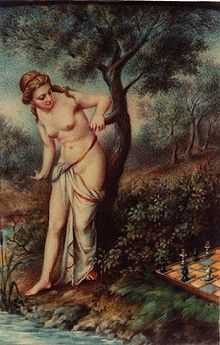Caïssa
Caïssa is a fictional Thracian dryad portrayed as the goddess of chess, as invented during the Renaissance by Italian poet Hieronymus Vida.
Vida's poem
Caïssa originated in a 658-line poem called Scacchia, Ludus published in 1527 by Hieronymus Vida (Marco Girolamo Vida), which describes in Latin Virgilian hexameters a chess game between Apollo and Mercury in the presence of the other gods. In it, to avoid unclassical references, the rooks are described as towers (armored howdahs) on elephants' backs, and the bishops as archers:
- Tum geminae velut extremis in cornibus arces
- hinc atque hinc altis stant propugnacula muris,
- quae dorso immanes gestant in bella Elephanti.
- "Then twin, as if at the ends, citadels in the corners,
- here and there stand ramparts with high walls,
- which, immense, are carried into war on the back by an elephant."
(A leaked unauthorized 742-line draft version was published in 1525. Its text is very different, and in it Caïssa is called Scacchia, the chess rook is a cyclops, and the chess bishop is a centaur archer.)
This led to the modern name "castle" for the chess rook, and thus the term "castling", and the modern shape of the European rook chesspiece. Also for a time, some chess players in Europe called the rook "elephant" and the bishop "archer". In German, Schütze ("archer") became a general word for a chess bishop until displaced by Läufer ("runner") in the 18th century.[1]
William Jones's poem
The pioneering English orientalist Sir William Jones re-used Vida's character Caïssa in 1763 in his own poem Caïssa written in Latin hexameters.[2][3][4][5] Jones also published an English-language version of the poem.[6][7]
In the poem, Caïssa initially repels the advances of the god of war, Mars. Spurned, Mars seeks the aid of the god of sport Euphron, brother of Venus, who creates the game of chess as a gift for Mars to win Caïssa's favor.
Modern use
Caïssa is referred to in chess commentary.
- Garry Kasparov uses this reference now and again, especially in his five-volume work My Great Predecessors. It is used as a substitute for being fortunate – "Caïssa was with me" – especially in unclear situations, for example in sacrifices.[8]
- The book The March of Chess Ideas by Anthony Saidy extensively uses Caïssa as well.
- T. R. Dawson extensively used Caïssa, both as a character to provide literary narrative to accompany his problem collections,[9] or merely as a convenient anthropomorphism of chess.[10]
Caïssa as a concept has also been explored by some who seek the evidence of the sacred feminine in chess.
The first computer program that won the World Computer Chess Championship (in 1974) was named Kaissa.
The card game Android: Netrunner features a program type named Caïssa, which are modeled after Chess pieces.
References
Notes
- ↑ Murray, H.J.R. (1913), A History of Chess, Benjamin Press (originally published by Oxford University Press), ISBN 0-936317-01-9
- ↑ Edward R. Brace, An Illustrated Dictionary of Chess, Hamlyn, 1979, ISBN 0-600-32920-8 p 52
- ↑ About chess: Caissa
- ↑ Brief notes on the history of chess 1500 chess-poster.com
- ↑ Caissa chessworld
- ↑ Philidor, A.D (1777), Systematic introduction to the game and the analysis of chess (L’analyze des échecs) (Fifth ed.), London, pp. 12–20
- ↑ English verse translation of the 1763 poem
- ↑ Kasparov, Garry (2003), Garry Kasparov on My Great Predecessors, Part 1 (First ed.), Everyman Chess, ISBN 1-85744-330-6
- ↑ Dawson, Thomas Rayner (1947). Caissa's Fairy Tales. Croydon, England: Privately published by the author. pp. 31–17.
- ↑ Dawson, Thomas Rayner (1913-07-10). "Caissa's Playthings". Cheltenham Examiner. Retrieved 2013-09-21.
Bibliography
- Dr Johnson, Samuel (1810), The works of English Poets from Chaucer to Cowper (Reprint ed.), London, p. 450
External links
- Text of Scacchia, Ludus, by Hieronymus Vida of Cremona (1559)
- Caïssa by William Jones 1763 edochess.ca/batgirl/
- Caissa's Web a selection of chess poems at members.caissa.com
